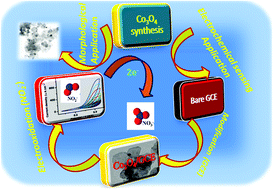Facile synthesis of Co3O4 disordered circular sheets for selective electrochemical determination of nitrite†
Abstract
The electrochemical nitrite sensing properties of a cobalt oxide (Co3O4) modified glassy carbon electrode were investigated. Co3O4 has been prepared using a simple precipitation method. The physical, phase transformation, purity and morphological studies were confirmed by several characterization techniques including XRD, TGA, FT-IR, RAMAN, XPS, SEM, TEM and HRTEM. In particular, Transmission Electron Microscopy studies revealed particle size in the range of 10–100 nm. Electrochemical techniques such as cyclic voltammetry and amperometry were employed to study the electrooxidation of the primary environmentally hazardous anion, nitrite (NO2−) on Co3O4/GCE. The sensitivities were found to be 0.318 μA mM−1 cm−2 and 0.600 μA mM−1 cm−2 corresponding to a linear range from 6.6 μM to 3.0 mM and 3 mM to 13.83 mM, respectively with a limit of detection (LOD) of 0.22 μM. The electrochemical sensor selectively detects nitrite even in the presence of common interferents. The sensor also demonstrates reliable operational stability, long term stability and good antifouling properties. The detection of nitrite in real samples of milk and water with excellent recovery demonstrates the practical application of our proposed sensor.


 Please wait while we load your content...
Please wait while we load your content...